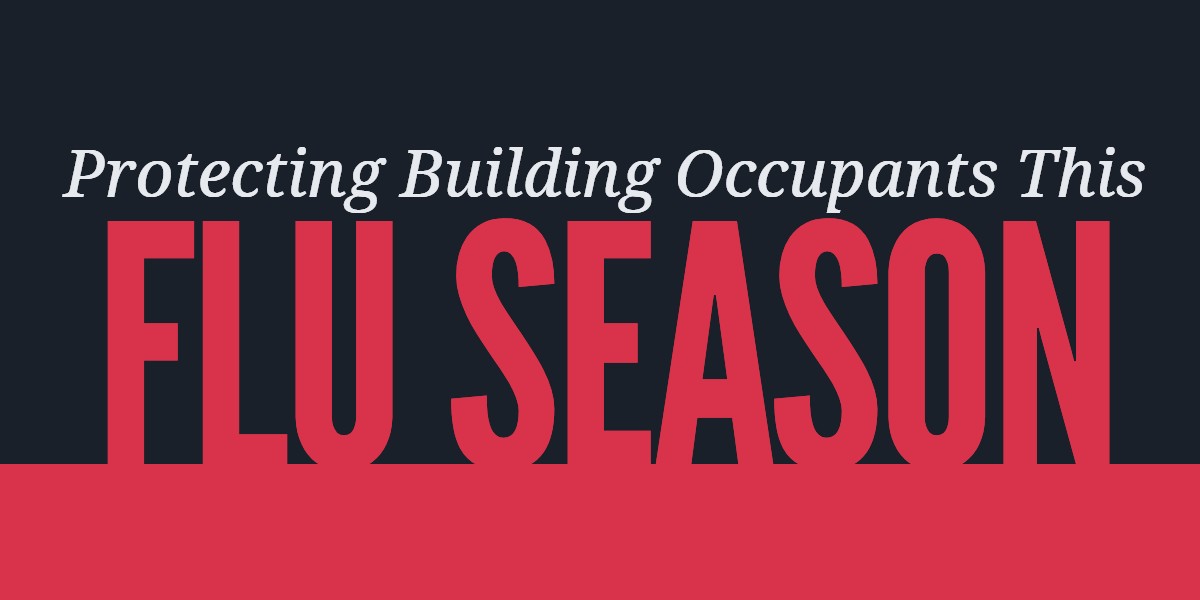The 2017-2018 flu season was the deadliest on record, leading to the deaths of tens of thousands of people, millions of sick days, and billions of dollars in lost productivity.

How to Protect Building Occupants This Flu Season
According to the U.S. Centers for Disease Control and Prevention (CDC), on average;
The annual direct costs, such as hospital and doctor’s office visits, medications, of influenza (flu) in the United States are an estimated $4.6 billion.
The flu causes U.S. employees to miss approximately 17 million workdays due to flu, at an estimated $7 billion a year in sick days and lost productivity.
Fortunately, there are several cost-effective methods schools and businesses can take to protect building occupants, as well as their profits and productivity, including:
- Scheduling extra cleaning cycles and wiping down high-contact surfaces.
- Enforcing handwashing policies.
- Increasing HVAC airflow, and;
- Installing high-flow HEPA filtration systems.
Extra Cleaning
Influenza can survive on hard, non-porous surfaces for up to 48 hours.
Droplets projected from a cough can spread up to 6 meters, while sneezing can spread droplets up to 8 meters--both remaining in the air for up to 10 minutes.
However, studies have demonstrated that you are far more likely--approximately 80 percent--to acquire the flu by touching a contaminated surface and then your eyes, mouth, or nose.
Increasing the rate of cleaning and the disinfection of high-contact surfaces--keyboards, computer mice, doorknobs, and water fountains--decreases the likelihood of coming into contact with the virus.
Handwashing Policies
As previously discussed, the flu is primarily passed via direct contact, either with a contaminated surface, or a sick person.
Unfortunately, studies have shown the handwashing habits of the average person, especially children, leaves a great deal to be desired.
This behavior can rapidly spread the flu throughout an entire office in a few short hours and increases the likelihood of ingestion and illness.
Encouraging or enforcing (where appropriate) high-quality hand hygiene will significantly reduce the spread of germs throughout your entire facility.
Make sure to stock the restrooms and kitchen areas with plenty of liquid foaming soap, paper towels, and hand sanitizer.
Additionally, explaining to employees or students, in detail, the potential consequences of not washing their hands well and regularly has been shown to positively impact compliance.
Airflow & Filtration
Increasing indoor airflow and quality will reduce the prevalence of influenza in the air via dispersion.
Adding high-flow HEPA filters to the HVAC system will ensure the virus is captured instead of being spread to other parts of your facility.
Additionally, modern air samplers and ionizers can help monitor, report, and prevent airborne infections.
[The] spread of infectious diseases in hospitals can be most significant.
In many situations there is a need for a pathogen- and particle-free environment, e.g. in operation wards, environments for immunosuppressed patients as well as for patients with serious allergies.
This makes it desirable to have a method not only for collection and identification but also for eliminating the virus and other pathogens from the air.
Ozone gas has been shown to inactivate norovirus and may be used in empty rooms to decontaminate surfaces.
Ionizing air affects influenza virus infectivity and prevents airborne-transmission
Tips to Stay Safe
Influenza is no laughing matter.
It is a deadly virus with no cure.
According to the CDC, many people may experience heart attacks as a result of the strain from being infected, and may never fully recover from the impact of the illness.
There is no predicting what variation of the viruses may arise during any particular season.
To protect yourself, co-workers, random strangers, as well as loved ones::
- Stay home when you're sick.
- Send sick workers and students home.
- Sneeze or cough into your elbow.
- Wash your hands regularly, especially after coming into contact with high-contact public surfaces and before eating.
- Avoid touching your face, eyes, and nose as much as possible.
References & Resources
Takeaway
Vaccination is the single best way to prevent infection and the spread of influenza.
Second to that is isolation, cleaning, and disinfection combined with the safe facilities practices listed in this article.
Keep in mind, there is no safe alternative to vaccination that isn't isolation, so to protect those around you, stay home if you're sick.
If you're an employer or school administrator, the most cost-effective, production-focused solution is to allow your employees or students to stay home and work remotely or makeup work after they have recovered.
If you would like to find out more about how your school or business can do more to protect students and employees this flu season.--contact us today for a free quote!
In Bakersfield CA, call (661) 437-3253
In Fresno CA, call (559) 206-1059
In Valencia CA, or Santa Clarita CA, call (661) 437-3253

